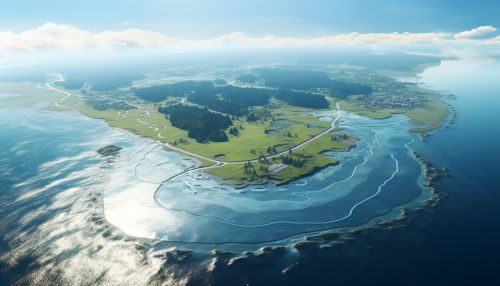Geoengineering
Overview
Geoengineering, also known as climate engineering, refers to the deliberate and large-scale intervention in the Earth's natural systems to counteract climate change. It encompasses two primary categories: Carbon Dioxide Removal (CDR) and Solar Radiation Management (SRM).


Carbon Dioxide Removal (CDR)
Carbon Dioxide Removal (CDR) techniques aim to remove carbon dioxide from the atmosphere, thereby reducing the greenhouse effect and slowing global warming. These methods can be further divided into natural and artificial techniques.
Natural Techniques
Natural techniques for CDR include afforestation, reforestation, and ocean fertilization. Afforestation and reforestation involve planting trees to absorb carbon dioxide, while ocean fertilization entails adding nutrients to the ocean to promote the growth of phytoplankton, which also absorbs carbon dioxide.
Artificial Techniques
Artificial techniques for CDR include direct air capture, bio-energy with carbon capture and storage (BECCS), and enhanced weathering. Direct air capture involves the use of machines to remove carbon dioxide directly from the ambient air. BECCS involves the combination of biomass use and carbon capture and storage to remove carbon dioxide. Enhanced weathering involves grinding up rocks that naturally absorb carbon dioxide and spreading them over a large area.
Solar Radiation Management (SRM)
Solar Radiation Management (SRM) techniques aim to reflect a small proportion of the Sun's energy back into space, thereby reducing the amount of heat that reaches the Earth's surface and cooling the planet. These methods include stratospheric aerosol injection, marine cloud brightening, and space-based reflectors.
Stratospheric Aerosol Injection
Stratospheric aerosol injection involves the release of aerosols into the stratosphere to reflect sunlight back into space. This method mimics the natural cooling effect that occurs after major volcanic eruptions.
Marine Cloud Brightening
Marine cloud brightening involves spraying sea water into the atmosphere to create or enhance clouds that can reflect sunlight back into space.
Space-Based Reflectors
Space-based reflectors involve the deployment of large mirrors or other reflective devices in space to reflect sunlight away from the Earth.
Risks and Controversies
While geoengineering offers potential solutions to climate change, it also carries significant risks and controversies. These include the potential for unforeseen side effects, the difficulty of global governance, and the moral hazard argument.
Unforeseen Side Effects
The large-scale manipulation of the Earth's natural systems could have unforeseen and potentially catastrophic side effects. For example, stratospheric aerosol injection could deplete the ozone layer, while ocean fertilization could disrupt marine ecosystems.
Global Governance
The global nature of geoengineering raises difficult questions about governance. Who should decide when and how geoengineering techniques are used? How can the interests of all nations be fairly represented?
Moral Hazard Argument
The moral hazard argument suggests that the availability of geoengineering could reduce the urgency to cut greenhouse gas emissions. This could lead to a situation where geoengineering is used as a substitute for emission reduction, rather than as a supplementary measure.
